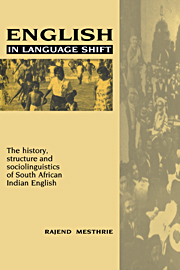 English in Language Shift
English in Language Shift Book contents
- Frontmatter
- Contents
- List of figures and maps
- List of tables
- Preface
- Acknowledgements
- List of abbreviations
- 1 Historical background: the shaping of a New English
- 2 Variation in SAIE: a first glimpse
- 3 Syntactic variation: the relative clause
- 4 Word-order principles
- 5 Non-syntactic variation
- 6 Perspectives from second-language acquisition
- 7 Perspectives from pidgin and creole studies
- Appendix A Comparison between SAIE sample and census data for Indians in Natal
- Appendix B Types of relative clauses used by individual speakers
- Appendix C Rank orders for relative clauses, topics and morphology
- Notes
- Sources and references
- Index
3 - Syntactic variation: the relative clause
Published online by Cambridge University Press: 03 December 2009
- Frontmatter
- Contents
- List of figures and maps
- List of tables
- Preface
- Acknowledgements
- List of abbreviations
- 1 Historical background: the shaping of a New English
- 2 Variation in SAIE: a first glimpse
- 3 Syntactic variation: the relative clause
- 4 Word-order principles
- 5 Non-syntactic variation
- 6 Perspectives from second-language acquisition
- 7 Perspectives from pidgin and creole studies
- Appendix A Comparison between SAIE sample and census data for Indians in Natal
- Appendix B Types of relative clauses used by individual speakers
- Appendix C Rank orders for relative clauses, topics and morphology
- Notes
- Sources and references
- Index
Summary
Introduction
My aim in this chapter is to examine in detail the kind of syntactic variation resulting from the language shift out of which SAIE arose, via analysis of a single phenomenon – the relative clause. Of a total of 15,530 sentences in the corpus, 543 involved restrictive relative clauses. A small number of non-restrictive clauses (six), infinitive relatives (three), and related constructions like clefts and pseudo-clefts were excluded from the analysis. The 543 relative clauses can be divided into nineteen categories, some startlingly different from options taken in standard English. The use of particular relativisation strategies will be shown to correlate with certain groups which can be characterised in social and linguistic terms, and according to the nature and level of language acquisition. A brief characterisation of the variation in relative-clause usage in British dialects will serve as a prelude to the diversity of SAIE forms.
Relative clauses in English dialects
The standard ways of forming relative clauses via appropriate relative pronouns (who for human NPs, with case variants whom and whose; which for non-human) and their alternatives with that (for any noun in principle) and zero for object relative NPs are too well known to describe in detail here. Information on other dialects is less easily forthcoming. Trudgill (1983a: 41) provides a list of possibilities within regional dialects of England, the first two being standard (and hence non-regional):
(1) He's a man who likes his beer.
(2) He's a man that likes his beer.
(3) He's a man at likes his beer.
(4) He's a man as likes his beer.
(5) He's a man what likes his beer.
[…]
- Type
- Chapter
- Information
- English in Language ShiftThe History, Structure and Sociolinguistics of South African Indian English, pp. 71 - 100Publisher: Cambridge University PressPrint publication year: 1993


